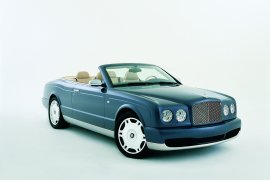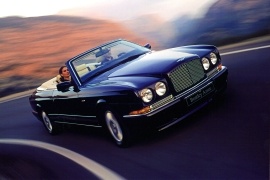BENTLEY Azure Models/Series Timeline, Specifications & Photos
First production year: 1995
Engines: Gasoline
Body style: Convertible (spider/spyder, cabrio/cabriolet, drop/open/soft top)
Stylish and extremely powerful. That’s what the Azure T was all about. The massive car was among the most elegant convertibles ever produced.
The Azure T was unveiled at the Los Angeles Auto Show, a convertible sporting the legendary 6.75-liter V8 engine developing 500 hp. It was the engine Bentley used produced for over half a century and kept improving it. The engine was mated to a 6-speed ZF automatic transmission and allowed the drive to switch between three transmission modes: Drive, Sport and Manual.
Buyers could opt for more performant brakes, a package that included huge ventilated carbon discs an eight piston calipers.
Despite its massive look, the Azure T was able to accelerate from 0 to 100 kph in only 5.2 seconds and had a top speed of 288 kph.
The Azure T had 20-inch 5-spoke wheels, a dual exhaust and no less than 42 exterior colors to choose from.
The car sported adaptive electro-hydraulic dampers to soften or firm depending on the road conditions.
The four-seater convertible was offered in a single trim level. The Standard level included xenon headlights, tri-zone climate control, a DVD navigation system and front and rear parking sensors. 20-inch alloys were offered optionally.
The safety equipment the Azure T was offered included front, rear and side airbags, antilock brakes, stability control and both front and rear parking sensors.
The 2006 Bentley Azure was the last convertible built on a chassis from an era when Rolls-Royce and Bentley brands were under the same roof and shared the same engines.
After Volkswagen bought the Crewe factory and the Bentley name and BMW bought the Rolls-Royce brand and the grille with the Spirit of Ecstasy, things didn't go too well between the German competitors. But Volkswagen didn't have an engine to suit a Bentley and didn't want to use the 4.4-liter V8 from the Bavarian company. So, the Volkswagen management decided to go with the old 6.75-liter Rolls-Royce/Bentley V8 engine but added two turbochargers.
The massive convertible was built for relaxed drivings and comfort. To achieve that, the vehicle had to be heavy, have a long wheelbase and thick chairs inside. The massive look of the car with a slightly sloped rear end had the classic look of a luxurious vehicle. And the Azure was nothing short on it.
Inside, the wood and leather were the main materials used. Some buttons were metallic while only a few were made out of plastic. The big, flat, chairs upfront had multiple adjustments and even a massage function. Over the years, that wasn't unusual but, in 2007, it was something extraordinary. An interesting feature was the dual inside opening handle, one for the front seat occupants and the other for the rear passengers who could reach and open the door.
Under the hood was the original 6.75-liter, twin-turbo engine. While the Bentley Continental Turbo had a big, single turbocharger, the Azure had two for a better response and smaller lag. Another improvement over the older Bentley was the 6-speed automatic gearbox that replaced the older 4-speed.
In the '90s, Bentley was nicknamed as the Rolls-Royce for the driver. It featured the same luxury, but the cabin was more driver-oriented. It was the same for the Azure, which was an open-top Continental R.
In the early '80s, Rolls-Royce management decided to design a Bentley that would not share the bodywork with a Rolls-Royce. To be offered exclusively as Bentley and resemble the glorious racing history of the B-winged brand. In 1991, at the Geneva Motor Show, the Continental R was unveiled in a surprise event. Four years later, based on the same platform, the British brand introduced the convertible version, the Azure.
Viewed from the front, the mesh-grille looked even more impressive due to its size, between the four rounded headlights designed in an old-fashion way. On the front fenders, there was a pair of air-vents, which didn't exist on the Continental R. The transformation was made by the Pininfarina studios and also built the shell and soft-top at their factory in Italy. Hence the Italian designers made the open-top luxury vehicle without a security arch, further reinforcements were required.
The interior was built for comfort. Even though the car resembled a sporty history, it had to be fitted with British luxury. Expensive leather and wood trims were extensively used in the handcrafted cabin. A “Sport” button was installed on the top of the gear selector that altered the engine and gearbox management, and also stiffened the suspension.
The powerful, turbocharged, 6.75-liter V8 was one of the torquiest engines installed in a regular car on those times. And it was upgraded over the years from 650 Nm (450 lb-ft) of torque up to 881 Nm (650 lb-ft).


